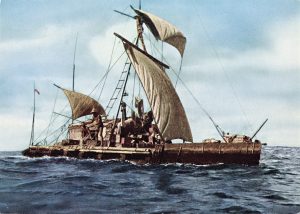 In the 1940s, Thor Heyerdahl from Norway theorised that the peoples of Polynesia were settled by the peoples of Peru rather than people of Asiatic descendent as was commonly accepted at that time. In the 1940's this idea was considered to be completely ludicrous and the academia and anthropological world both in Europe and later America simply snubbed him. His unremitting spirit looked elsewhere as Heyerdahl was not willing to simply quit. Eventually he was able to gain financial support in the form of private loans and additional aid from the US Army and he was able to put this idea to the test by travelling across 4,300 miles of the Pacific ocean on a raft !
In the 1940s, Thor Heyerdahl from Norway theorised that the peoples of Polynesia were settled by the peoples of Peru rather than people of Asiatic descendent as was commonly accepted at that time. In the 1940's this idea was considered to be completely ludicrous and the academia and anthropological world both in Europe and later America simply snubbed him. His unremitting spirit looked elsewhere as Heyerdahl was not willing to simply quit. Eventually he was able to gain financial support in the form of private loans and additional aid from the US Army and he was able to put this idea to the test by travelling across 4,300 miles of the Pacific ocean on a raft !
In 1947 he and his five men crew departed from Calloa, Peru and set off on a trans-Pacific voyage for the Polynesian islands on a raft named Kon-Tiki named after a Pre- Incan (and later Incan) God of all things. The raft was made mostly of balsa- wood, a wood native to Peru during the time of Polynesia's settlement. With only a crew of five, one hundred and one days later Heyerdahl made it to the Tuamotu islands in eastern Polynesia much to the surprise of the world. To put it in perspective they travelled on a one sail primitive raft for 101 days across 4,300 miles of Pacific Ocean in comparison to a nearly 70 day voyage on the Pinta ship across 3, 568 miles of Atlantic ocean by explorer Christopher Columbus as he and his crew ventured from a port in Spain to finding the New World in October of 1492.

Today the Kon-Tiki raft is on display in Oslo, Norway inside the Kon-Tiki museum. After Thor returned from his the Kon TIki voyage he went on to write a number one international selling book and is listed below. He later lived many days out in the beautiful Canary Islands where there is a museum , the Piramades de Guima about his life and work. Despite the DNA testing of today which some claim does not show evidence of Peruvians in Polynesia dating to their earliest settlements it is still rather a remarkable voyage. Perhaps the romantic notion of a heroic voyager is not to be forgotten and perhaps some still hold to the belief his theory may maintain portions of historical truth. Captain , my Captain ! and to quote the Andrew Sister's song from 1948 "Civilization what does it all Mean? "


Add a comment to: Kon Tiki